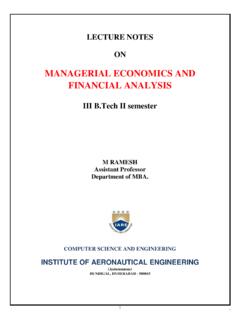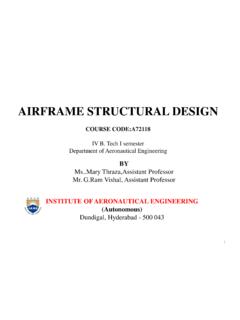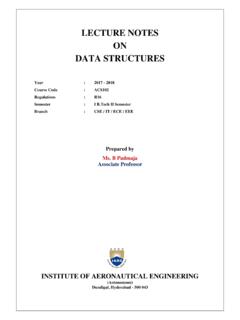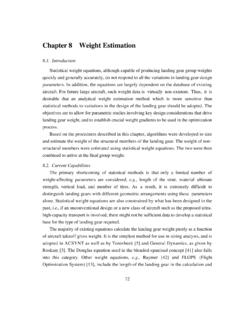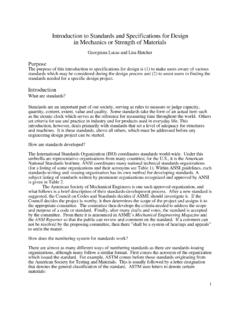Transcription of LECTURE NOTES ON VLSI DESIGN B.Tech VII semester (R16)
1 1 LECTURE NOTES ON VLSI DESIGN VII semester (R16) Seshagiri Rao , Associate Professor Dr. V Vijay, Associate Professor Dr. M Manisha, Associate Professor Ms , Assistant Professor ELECTRONICS AND COMMUNICATION ENGINEERING INSTITUTE OF AERONAUTICAL ENGINEERING (Autonomous) DUNDIGAL, HYDERABAD - 500043 2 UNIT-I MOSFETS 3 Fundamentals of MOSFETs In 1958, Jack Kilby built the first integrated circuit flip-flop with two transistors at Texas Instruments. In 2008, Intel s Itanium microprocessor contained more than 2 billion transistors and a 16 Gb Flash memory contained more than 4 billion transistors. This corresponds to a compound annual growth rate of 53% over 50 years. No other technology in history has sustained such a high growth rate lasting for so long. This incredible growth has come from steady miniaturization of transistors and improvements in manufacturing processes.
2 Most other fields of engineering involve tradeoffs between performance, power, and price. However, as transistors become smaller, they also become faster, dissipate less power, and are cheaper to manufacture. This synergy has not only revolutionized electronics, but also society at large. The processing performance once dedicated to secret government supercomputers is now available in disposable cellular telephones. The memory once needed for an entire company s accounting system is now carried by a teenager in her iPod. Improvements in integrated circuits have enabled space exploration, made automobiles safer and more fuel efficient, revolutionized the nature of warfare, brought much of mankind s knowledge to our Web browsers, and made the world a flatter place. Fig. shows annual sales in the worldwide semiconductor market.
3 Integrated circuits became a $100 billion/year business in 1994. In 2007, the industry manufactured approximately 6 quintillion (6 1018) transistors, or nearly a billion for every human being on the planet. Thousands of engineers have made their fortunes in the field. New fortunes lie ahead for those with innovative ideas and the talent to bring those ideas to reality. During the first half of the twentieth century, electronic circuits used large, expensive, power-hungry, and unreliable vacuum tubes. In 1947, John Bardeen and Walter Brattain built the first functioning point contact transistor at Bell Laboratories. It was nearly classified as a military secret, but Bell Labs publicly introduced the device the following year. Fig Ten years later, Jack Kilby at Texas Instruments realized the potential for miniaturization if multiple transistors could be built on one piece of silicon.
4 Figure (b) shows his first prototype of an integrated circuit, constructed from a germanium slice and gold wires. The invention of the transistor earned the Nobel Prize in Physics in 1956 for Bardeen, Brattain, and their supervisor William Shockley. Kilby received the Nobel Prize in Physics in 2000 for the invention of the integrated circuit. Transistors can be viewed as electrically controlled switches with a control terminal and two other terminals that are connected or disconnected depending on the voltage or current applied to the control. Soon after inventing the point contact transistor, Bell Labs developed the bipolar junction transistor. Bipolar transistors were more reliable, less noisy, and more power-efficient. 4 FIGURE (a) First transistor (Property of AT&T Archives. Reprinted with permission of AT&T.)
5 And (b) first integrated circuit (Courtesy of Texas Instruments.) Early integrated circuits primarily used bipolar transistors. Bipolar transistors require a small current into the control (base) terminal to switch much larger currents between the other two (emitter and collector) terminals. The quiescent power dissipated by these base currents, drawn even when the circuit is not switching, limits the maximum number of transistors that can be integrated onto a single die. By the 1960s, Metal Oxide Semiconductor Field Effect Transistors (MOSFETs) began to enter production. MOSFETs offer the compelling advantage that they draw almost zero control current while idle. They come in two flavors: nMOS and pMOS, using n-type and p-type silicon, respectively. The original idea of field effect transistors dated back to the German scientist Julius Lilienfield in 1925 and a structure closely resembling the MOSFET was proposed in 1935 by Oskar Heil.
6 But materials problems foiled early attempts to make functioning devices. In 1963, Frank Wanlass at Fairchild described the first logic gates using MOSFETs . Fairchild s gates used both nMOS and pMOS transistors, earning the name Complementary Metal Oxide Semiconductor, and CMOS. The circuits used discrete transistors but consumed only nanowatts of power, six orders of magnitude less than their bipolar counterparts. With the development of the silicon planar process, MOS integrated circuits became attractive for their low cost because each transistor occupied less area and the fabrication process was simpler . Early commercial processes used only pMOS transistors and suffered from poor performance, yield, and reliability. Processes using nMOS transistors became common in the 1970s.
7 Intel pioneered nMOS technology with its 1101 256-bit static random access memory and 4004 4-bit microprocessor, as shown in Figure While the nMOS process was less expensive than CMOS, nMOS logic gates still consumed power while idle. Power consumption became a major issue in the 1980s as hundreds of thousands of transistors were integrated onto a single die. CMOS processes were widely adopted and have essentially replaced nMOS and bipolar processes for nearly all digital logic applications. In 1965, Gordon Moore observed that plotting the number of transistors that can be most economically manufactured on a chip gives a straight line on a semilogarithmic scale . At the time, he found transistor count doubling every 18 months. This observation has been called Moore s Law and has become a self-fulfilling prophecy.
8 Figure shows that the number of transistors in Intel microprocessors has doubled every 26 months since the invention of the 4004. Moore s Law is driven primarily by scaling down the size of transistors and, to a minor extent, by building larger chips. The level of integration of chips has been classified as small-scale, medium-scale, large-scale, and very large scale. Small-scale integration (SSI) circuits, such as the 7404 inverter, have fewer than 10 gates, with roughly half a dozen transistors per gate. Medium-scale integration (MSI) circuits, such as the 74161 counter, have up to 1000 gates. Large-scale integration 5 (LSI) circuits, such as simple 8-bit microprocessors, have up to 10,000 gates. It soon became apparent that new names would have to be created every five years if this naming trend continued and thus the term very large-scale integration (VLSI) is used to describe most integrated circuits from the 1980s onward.
9 A corollary of Moore s law is Dennard s Scaling Law [Dennard74]: as transistors shrink, they become faster, consume less power, and are cheaper to manufacture. Intel microprocessor clock frequencies have doubled roughly every 34 frequency scaling hit the power wall around 2004, and clock frequencies have leveled off around 3 GHz. Computer performance, measured in time to run an application, has advanced even more than raw clock speed. Presently, the performance is driven by the number of cores on a chip rather than by the clock. Even though an individual CMOS transistor uses very little energy each time it switches, the enormous number of transistors switching at very high rates of speed has made power consumption a major DESIGN consideration again. Moreover, as transistors have become so small, they cease to turn completely OFF.
10 Small amounts of current leaking through each transistor now lead to significant power consumption when multiplied by millions or billions of transistors on a chip. The feature size of a CMOS manufacturing process refers to the minimum dimension of a transistor that can be reliably built. The 4004 had a feature size of 10 m in 1971. The Core 2 Duo had a feature size of 45 nm in 2008. Manufacturers introduce a new process generation (also called a technology node) every 2 3 years with a 30% smaller feature size to pack twice as many transistors in the same area. Feature sizes down to m are generally specified in microns (10 6 m), while smaller feature sizes are expressed in nanometers (10 9 m). Effects that were relatively minor in micron processes, such as transistor leakage, variations in characteristics of adjacent transistors, and wire resistance, are of great significance in nanometer processes.
